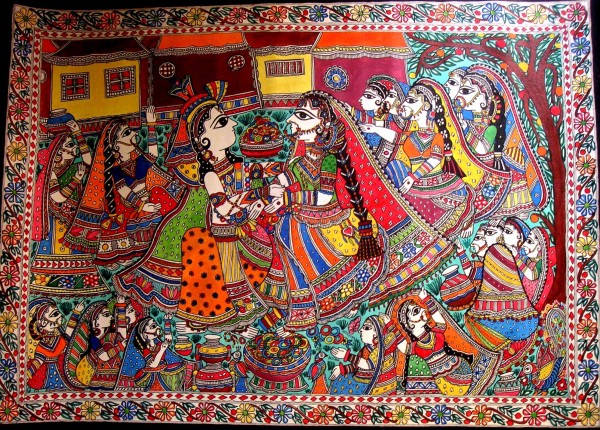Madhubani Paintings The Ancient Traditional Art
Madhubani Paintings:
Madhubani paintings the famous traditional paintings from ancient India. These paintings are beautiful and made with natural colours. Madhubani Art was practised in ancient Mithila, once the capital of Janaka Maharaj, father of Sita in Ramayana. So this painting was famous as Mithila Painting. The images were born in the village of Madhubani. Hence, the pictures became famous as Madhubani Paintings. Still, the style of the photographs attracting the youth, and a wide variety of designs also occurred in making this art.
Madhubani art in Ramayana:
From the epic stories, Mithila was an ancient kingdom, the most potent capital of eastern India. It was huge and spread to present north-eastern India and the southern Terai region of Nepal. On the occasion of Sita’s marriage to Lord Rama, Janaka, the father of Sita, commissioned artists to do the Madhubani designs to decorate the wedding premises to attract guests. In the ancient period and at present, most of the Madhubani paintings have been done by the women around the current villages of Madhubani and Mithila. The artists painted Madhubani paintings on the mud walls of the huts. Gradually, the tradition changed to drawing art paintings on cloth or handmade paper canvas.

Reputation
In the mid of 1965, Madhubani and Mittali faced severe drought. The villagers faced many problems, like starvation for many days. The central government took action to aid the area people and the artists who have been following the decoration of the houses with Madhubani paintings. Then Bhaskar Kulkarni, the aid worker for the Indian government, arrived at the village to study the art and encouraged the artists to draw the same pictures on paper instead of clay-coated walls. Even she freely supplied materials like paper and colours to the artists. The encouragement caused the artists to draw Madhubani Folk art very attractively.
Later the government sold the painting through government handicraft shops nationwide to contribute the artists to the artists. Through the government’s efforts and the encouragement of Bhaskar Kulkarni, the images became famous as Madhubani Paintings.
Madhubani Painting Designs:
The themes of Madhubani art revolve around epics, myths, and Puranas. The pieces of the paintings are adopted from the brave stories of Gandharvas, the beauty of apsaras. However, the stories of the images are based on teaching morals to the public. The artists adopt the themes not only from Hinduism but also from Buddhism. Why do the artists paint mostly spiritual subjects and Gods? Because they desire to please the Gods for easily sustain in life. At the time of wedding ceremonies and on auspicious days, the artists embellish the walls of their homes with mythological story drawings—the wedding rooms are decorated with symbolic paintings like fertility in life.
There are three variations of styles in progress. 1. Bharni Paintings. 2. Kayastha Kachina Paintings. 3. Tattoo Paintings of the Dusadh community.
Bharni Paintings:
Bharni Paintings are one of the styles among Madhubani Paintings. The painters used mixed rich colours to attract the attention of the spectators. These rich colours made the designs rich and lavished the paintings. The theme of the image is mainly adopted from the Hindu mythologies, God incarnation stories. The Bharani painting style is colourful with rich line forms. Drawing the documents for the artists is very easy due to their mythological knowledge. The artist’s common subjects are Lord Vishnu, Goddess Kali, Goddess Durga, Lord Krishna, and other Gods and goddesses.
Kayastha Kachina Paintings:
With the support of the Indian government, many women artists started drawing Madhubani paintings on paper to earn money. The artists also get fame in their Kayastha community. They also wanted to make their art forms worthy, so they came forward with a new style of line paintings. In a unique feature of the Kayastha tradition, the artists use only monochrome or just two colours, called Katchni paintings. First, Ganga Devi draws this painting style from Raseedput village of Madhubani district.
Tattoo Painting of Dusadh Community:
Dusadh community people are landless and belong to the lower castes. They have been servicing the upper caste people for many years. After seeing the success of Madhubani artists and their earnings, their inner urge caused them to draw paintings on paper for extra income for household purposes. These people were encouraged by Bhasker Kulkarni and German anthropologist Erica Moser. Jamuna Devi was the first Dalit woman who started these paintings. The theme of the image is their legends, songs, and rituals associated with the Rahu, Sun, Moon and their cultural hero Raja Sailesh.
Well written, original information , it was really helpful in my research on mithila paintaings.